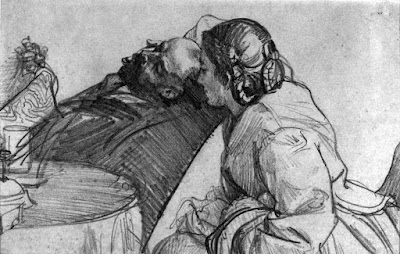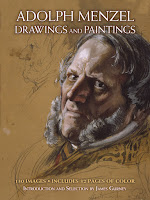Tom, I haven't found any evidence that Menzel ever used a camera obscura. But he was definitely aware of the benefits and pitfalls of reference photography to the artist, and he wrote about the issue.
He owned a collection of photographs of armor and weapons from the history museum in Dresden, but he still drew from observation the historical props he needed for a given picture, partly to understand them from different angles.
 |
[Portrait study of Maximilian von Schwerin-Putzar].
1864. Pencil, watercolor, gouache on toned paper. 30.1 x 22.5 cm.
[11.9 x 8.9 in.] KK. © bpk/ Kupferstichkabinett/SMB/Jörg P. Anders14
|
In general, he rejected the use of reference photography unless it was absolutely necessary. In the early 1860s, when he was preparing the gigantic painting of the Coronation of Wilhelm I, King of Prussia, he had to paint 132 portrait likenesses. He could have used photography for reference, but he chose to work from life studies instead.
 |
Portrait study of Emil von Webern. 1863. Pencil, watercolor, heightened with white on toned paper.
28.9 x 23.0 cm. [11.4 x 9 in.] KK. Copyright © bpk/ Kupferstichkabinett/SMB/Jörg P. Anders
|
Menzel wrote that the use of photography “is diametrically opposed to my belief in the responsibility of the artist to art and his self-confidence; and even the continuation of such a method must necessarily lead to the loss of discipline in certain important powers of the eyes, the hand, the memory, and the imagination concerning animated nature.”
Such attitudes may have seemed old fashioned to many of Menzel’s contemporary artists, who by the late nineteenth century were beginning to rely on photography’s documentary powers. In fact, Menzel was keenly interested in the new invention. Starting in 1864 his brother Richard ran a successful photography business, which produced reproductions of Menzel’s work.
After Richard’s death, Menzel advised his sister-in-law in the running of the business. According to Max Liebermann, who knew his artistic sensibilities well, “His visual sense, naturally inclined towards the observation and reproduction of the tiniest details, received fresh stimulus from photography.”
 |
Emilie und Richard [Emilie and Richard]. 1865.
Pencil on paper. Courtesy of Dr. Czok, Chairwoman, Adolph Menzel Society. |
After Richard’s death, Menzel advised his sister-in-law in the running of the business. According to Max Liebermann, who knew his artistic sensibilities well, “His visual sense, naturally inclined towards the observation and reproduction of the tiniest details, received fresh stimulus from photography.”
 This is an excerpt from the Introduction of my new book from Dover. The images in this post all appear in the book. The book contains 130 images, including 32 pages of color. Note: the listing on Amazon
This is an excerpt from the Introduction of my new book from Dover. The images in this post all appear in the book. The book contains 130 images, including 32 pages of color. Note: the listing on AmazonAdolph Menzel: Drawings and Paintings from JamesGurney.com








6 comments:
James,
Are the paintings in this article oil on some kind of board? Some of them look like gouache or some water based medium anyway
Just read the small notes, whoops :D
Menzel had the typical Prussian mentality: He was as implacable against his models as he was against himself: "There was no pause", I read here, "he once coerced a poor chap for two hours of rigor in his assigned pose. Whoever sat for him had to strictly obey and was not even allowed to stretch his members, stiffened by the hours, before the master himself had "enough of it". A cavalryman sitting on a horse for a long time, fell down after fading: Menzel quickly sketched on, before bringing him some water and helping him up."
It also would fit into the prussian picture that Menzel dubbed Impressionism as "the art of laziness".
Btw. I see a parallel between him and Cezanne:
Cezanne, after having finished a model session which took him almost hundred hours, in the end stated: "I'm not dissatisfied with the shirt collar".
Menzel, after having finished his wonderful candle-lit "Flute Concert", portraying Frederick the Great on the instrument with a rapt listening entourage, stated:
"I am not dissatisfied with the chandelier".
I also find this very candle-luster to be this painting´s "Highlight";-)
Rich, that is really interesting information about Menzel. Thanks.
I am curious about the differences between this new Menzel book and "Adolph Menzel, 1815-1905: Between Romanticism and Impressionism" by Claude Keisch (Editor), Marie-Ursula Riemann-Reyher (Editor)
Does this new book feature a lot more pieces of his work? Or different artworks not included in the older one?
Menzel certainly deserves this kind of attention.
John, that's a great book too, a catalog for the 1997 exhibition. Mr. Keisch has contributed an essay to our book, too. Our book is more art and less text, and what text there is focuses more on practicalities. Menzel is so prolific that the two books don't overlap very much. Our book leaves out the oils, which are often reproduced elsewhere, and focuses more on gouaches and drawings.
Post a Comment